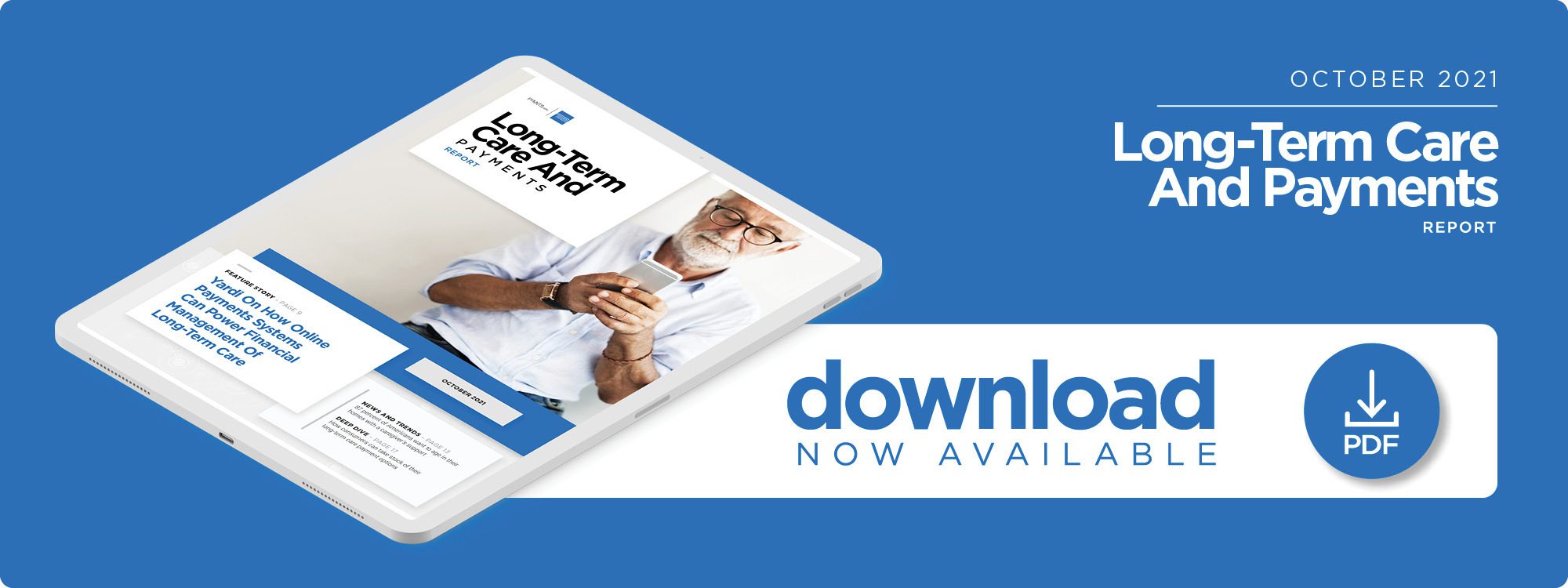Yardi on How Online Payments Systems Can Power Financial Management of Senior Living

With long-term and senior care costs rising, aging Americans and their families are unsure how they’ll manage them once they reach retirement age. In the Long-Term Care And Payments Report, Ray Elliott, vice president of senior living at property management software provider Yardi, tells PYMNTS how all-in-one online billing is eliminating long-standing friction.
The baby boomer generation is known for being one of the largest generations in history and for its extended lifespan.
As this generation outlives its predecessors, providing and paying for senior care poses a new set of financial challenges, for both aging adults and their families. Transferring basic operations online such as bill payment and activity registration can ease some of the burden for families and allow senior care professionals to better analyze trends among the senior living community, said Ray Elliott, vice president of senior living at property management software provider Yardi.
“When I talk about payers, typically it’s a child of the resident or multiple children,” said Elliott. “It could just as easily be some form of insurance, and it could be some combination of that. So, the system is set up so that you’ve got one bill that’s due, but a number of different payers. They could all be contributing toward the payment of that bill … [Yardi’s platform is] structured in a way that a number of different entities could make the payments.”
Less than one-quarter of U.S. citizens ages 67 to 73 are confident that they can pay all their medical expenses, meaning other parties most likely will be involved in the planning and executing of their care. The digitization of the senior care payments space provides family members and other payers with transparency into the patient’s financial situation and day-to-day activities. Access to online billing systems then permits involved parties to synchronously plan for upcoming costs and divide fees among payers or insurance providers.
Traditional Payment Practices Create Friction in the Senior Care Payments Space
Younger generations historically display a greater willingness to adopt new payments technology, yet older generations adopted online banking practices out of necessity during the pandemic. A report by the American Bankers Association (ABA) and Accenture showed 68% of baby boomers had increased online banking use, and 85% of respondents will continue conducting some or all of their transactions digitally. The overwhelming approval rate of online banking can be attributed, at least in part, to the numerous conveniences and reduction in friction when compared to antiquated paper processes.
“I think the biggest challenge [in the senior care payments space] is just manual payments,” Elliott said. “Still, a lot of operators are offering that and allowing residents to pay by check, but to me, there are just a lot of unnecessary steps — the mailing of statements, the receiving and processing of paper checks. When you get a check and it doesn’t match what the resident owes, correctly applying the payments to the open receivables can be complicated. To me, it just seems like it’s a labor-intensive manual process.”
It is not uncommon for more than one individual to partake in the senior care payments process. One of the older adult’s children may pay for housing, for example, while another might cover caregiving expenses. Sending and receiving documentation by mail is slower than online transactions, and all parties involved may not receive the proper correspondence. With an all-in-one digital platform, everyone has access to the same information.
“And then on top of that, [there is] some level of risk of applying the payment to an incorrect resident, you know, those kinds of issues,” continued Elliott. “There’s a lot of friction points there, whereas, if they [use] electronic payments and pay for it online or have autopay, it’s just a lot easier [to see] what’s being paid for, and it also ends up, for the consumer, that they have more control of that as well.”
Consumers Want to Choose How They Pay for Senior Care
Interest in digital avenues spans a multitude of marketplaces. A PYMNTS report showed 49% of consumers are highly interested in receiving online banking services from a large company, and 28% are “extremely” or “very” interested in obtaining online banking services from large retailers. Forty-one percent are interested in the same services from their employers. Evidence also suggests that consumers use a variety of digital methods to organize their finances.
“I think, certainly in senior living as I’m sure with other markets, any time you can offer choice to the resident or to the payers, it’s an attractive thing,” Elliott said. “Nobody wants to be told that there’s only one way that you can do this and, you know, you don’t have a choice on what you want to do. I think for the payers, [electronic payments] provides more flexibility to choose what payment method is best for them.”
There are several different ways to finance senior care costs, whether out-of-pocket, some form of supplemental insurance or a government-assisted program such as Medicaid. Many older adults are not aware of the actual cost of senior care, and those who rely on Medicare may not be aware that it does not cover everything. The patient or a family member likely will need to cover some portion of senior care expenses from their personal accounts. In this scenario, the option to pay by credit card can be particularly attractive because rewards points may help to offset the extra costs.
“Again, some will ultimately choose the physical check, but I think a lot of others are looking to pay electronically and use a credit or debit card,” added Elliott. “In terms of the message from the community, I think it just gives the resident confidence that we understand that one size doesn’t fit all. And, like I said, I think that is important in the senior living market. They want to feel like they’re being listened to.”
